Calgary's feral rabbits thriving in the southeast community of Seton
There is a squad of formerly domestic rabbits running wild in the southeast community of Seton.
They're chewing, digging, hopping, burrowing and breeding like, well, rabbits.
Local legend has it that three domestic bunnies were released in a field near the South Health Campus by a pet owner who got tired of them. In the years that have followed, those three have multiplied into more than 100.
They've turned into an attraction for many families in the area. Chanae Smith brought her two young daughters, Araya and Hatley, to watch the rabbits on Seton Crescent S.E. near the TD Canada Trust branch.
"I think they're just excited to see another little creature not too much smaller than them really," she said.
 A squad of formerly domestic rabbits is running wild in the community of Seton. Jonathan MacDonald said he and his five-month-old dog often spot multiple rabbits when they go out for a walk.
A squad of formerly domestic rabbits is running wild in the community of Seton. Jonathan MacDonald said he and his five-month-old dog often spot multiple rabbits when they go out for a walk.
"The dog's been good around them since he started training, which is really great," said MacDonald. "We have seen a coyote in the area a few times, kind of tracking them, but other than that they've been fine for me."
The rabbits forage wherever they can and are devouring much of the grass in the area. Some people have taken to feeding them, but Kyla Rae says that's not a good idea. Rae is a technician assistant at the Calgary Avian & Exotic Pet Clinic.
"These guys have a really special digestive system," Rae said. "It's very complicated, but they get all the nutrition they need from the dead grass and the roots that they're able to bring up with their paws, digging in the ground even though there's snow."
Rae says there is a health danger for the domestic animals called Rabbit Hemorrhagic Disease. It's highly contagious, there is no known cure and it is terminal.
"They get really tired," said Rae. "They're not eating as much and then we see that bleeding is the most common thing, so we'll see bleeding from the mouth, from the back end and they just become non-responsive."
Hares are not susceptible to the disease; it's only specific to feral domestic rabbits.
"This disease, it can come into your house on your shoes or your hands," said Rae. "If you decide that you want to pet a cute (feral) bunny, we all understand that people want to do that, but you can bring (the disease) in, so hygiene – if you have rabbits at home – is a really big thing."
The rabbits have developed a taste for bark in the area and they have stripped the bottom 30 centimetres from many trees. John Ostrowdun is the manager at Greengate Garden Centres, and says rabbits can cause severe damage to mature trees.
"It doesn't take much to kill a tree," he said. "All those chewing animals can do a lot of damage very quickly, you might not see the damage till spring (and when) your tree doesn't leaf out, you're like, 'what's going on,' and then you see this ring around it."
 Damage to a tree caused by formerly domestic rabbits running wild in the community of Seton. The Calgary Humane Society says it receives calls daily about the feral rabbit population through out the city. It's not currently accepting large rabbits and it asks the public to leave them alone.
Damage to a tree caused by formerly domestic rabbits running wild in the community of Seton. The Calgary Humane Society says it receives calls daily about the feral rabbit population through out the city. It's not currently accepting large rabbits and it asks the public to leave them alone.
It says in many cases feral rabbits wouldn't be adoptable because they're considered wild, and while some came from a domestic background, they've been outside for too long and wouldn't thrive in a home environment.
The humane society recommends to leave the rabbits where they are, unless they appear sick or injured. In those cases, if the rabbit can be caught, it can be taken to a 24-hour vet clinic for treatment.
To learn more about what to do if you find a stray rabbit, you can visit the Calgary Humane Society's website.
CTVNews.ca Top Stories

Quebec man, 81, gets prison sentence after admitting to killing wife with Alzheimer's disease
An 81-year-old Quebec man has been sentenced to prison after admitting to killing his wife with Alzheimer's disease.
Canada Post quarterly loss tops $300M as strike hits second week -- and rivals step in
Canada Post saw hundreds of millions of dollars drain out of its coffers last quarter, due largely to its dwindling share of the parcels market, while an ongoing strike continues to batter its bottom line.
'Immoral depravity': Two men convicted in case of frozen migrant family in Manitoba
A jury has found two men guilty on human smuggling charges in a case where a family from India froze to death in Manitoba while trying to walk across the Canada-U.S. border.
Prime Minister Trudeau attends Taylor Swift's Eras Tour in Toronto with family
Prime Minister Justin Trudeau is a Swiftie. His office confirmed to CTV News Toronto that he and members of his family are attending the penultimate show of Taylor Swift's 'The Eras Tour' in Toronto on Friday evening.
Trump supporters review-bomb B.C. floral shop by accident
A small business owner from B.C.'s Fraser Valley is speaking out after being review-bombed by confused supporters of U.S. president-elect Donald Trump this week.
Pat King found guilty of mischief for role in 'Freedom Convoy'
Pat King, one of the most prominent figures of the 2022 'Freedom Convoy' in Ottawa, has been found guilty on five counts including mischief and disobeying a court order.
Nearly 46,000 electric vehicles recalled in Canada over power loss risk
Nearly 46,000 electric vehicles from Kia, Hyundai and Genesis are being recalled in Canada over a potential power loss issue that can increase the risk of a crash.
Trump chooses Bessent to be Treasury secretary and Vought as top budget official
President-elect Donald Trump announced Friday that he'll nominate hedge fund manager Scott Bessent, an advocate for deficit reduction, to serve as his next treasury secretary. Trump also said he would nominate Russel Vought to lead the Office of Management and Budget.
Canada's tax relief plan: Who gets a cheque?
The Canadian government has unveiled its plans for a sweeping GST/HST pause on select items during the holiday period. The day after the announcement, questions remain on how the whole thing will work.


































